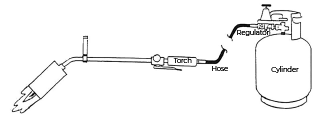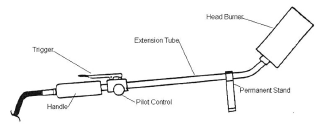
Operators should handle their equipment carefully. Always protect the soft brass valve of the gas cylinder as it can easily break or crack and a broken valve could turn the cylinder into a torpedo. Check all cylinders before refilling. Never overfill a cylinder as it could explode.
Tanks
- Protect cylinder valves; where possible, use cylinders that have valve protection welded to the cylinder.
- Propane tanks are pressurized, do not puncture or subject them to extreme heat.
- Secure propane tanks in an upright position and place them at least 3 m (10 ft) from the open flame.
- Close the propane cylinder valve first and let the remaining gas burn out of the hose before closing the torch valve when shutting off the torch.
- Plug the valve with a plastic plug when cylinder is not in use.
- Do not heat a cylinder to increase pressure other than with an approved tank heating device/system that is designed for use with vapour-withdrawal cylinders.
- Do not fill gas cylinder or bottle in need of repair.
- Tighten all fittings with a proper open-end wrench or crescent wrench.
Regulators
- Use a ULC listed and CGA approved regulator with the torch.
- Make sure flow of gas through the regulator is in the proper direction. Directional flow is stamped on the regulator.
- Keep vent in the pressure regulator clear at all times.
- Do not use an adjustable regulator with a higher pressure range than the one that came with the torch.
- Do not operate any pressure gauge beyond the top of its scale or near excessive heat (above 47°C or 117°F) or where there is excessive vibration.
- Tighten all fittings with a proper open-end wrench or crescent wrench.
Hoses
- Check hoses for wear and tear. Replace damaged hoses.
- Use only CGA approved hoses listed for liquid propane gas.
- Do not use a hose longer than 15 m (50 ft).
Torches
- Use a CGA approved torch only.
- Use an adjustable pilot light with a complete shut-off.
- Use a torch stand to direct flame upward when not in use.

- Use only torch machines equipped with the same safety features as described for torches. They should also have individually adjustable torches. Use only torch trolleys and multiple head machines with approved safety valves.
- Ignite burner with a flint or electronic lighter. Matches or disposable lighters are unsafe substitutes.
- Treat the torch as if it is always burning. On bright days, it is very hard to see the flame, and when working around operating mechanical equipment, it can be difficult to hear the torch operating.
- The torch flame must be visible at all times. When working with torches in areas where an area may be hidden, pull material away, heat it, and then apply it to the flashing.
- Do not leave lighted torch unattended for any reason.
- Do not lay an operating torch to rest on a gas cylinder. Do not play with a torch. A flame can be hard to see on a bright day and can ignite skin or clothing instantly.
Fire Extinguishers
- Have at least one fire extinguisher on the roof within a close proximity to the torch operator.
- Train each worker in the proper use of fire extinguishers.
- Direct the stream from a dry chemical type fire extinguisher at the base of the fire from a distance of at least 3 m (10 ft). Sweep the fire away from you, starting at its nearest point and moving the chemical stream toward the farthest point.
- Do not try to put out a cylinder fire if it cannot be done without tipping the cylinder. Let it burn and call the fire department.
- Do not place a fire extinguisher too close to the liquid propane gas equipment. If a fire breaks out, you may not be able to get at the fire extinguisher to put out the fire.
